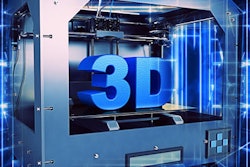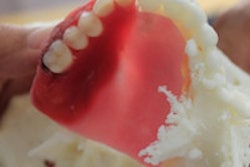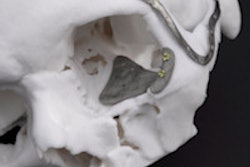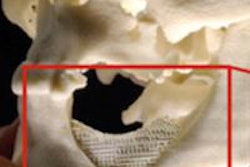
SAN FRANCISCO - Injuries, birth defects such as cleft palates, or surgery to remove a tumor can create gaps in bone that are too large to heal naturally. And when they occur in the head, face, or jaw, these bone defects can dramatically alter a person's appearance.
Now, researchers at Texas A&M University have developed a "self-fitting" material that expands with warm salt water to precisely fill bone defects and also acts as a scaffold for new bone growth.
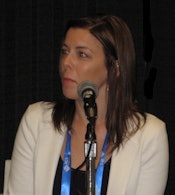 Melissa Grunlan, PhD, associate professor of biomedical engineering, Texas A&M University.
Melissa Grunlan, PhD, associate professor of biomedical engineering, Texas A&M University.Lead researcher Melissa Grunlan, PhD, an associate professor in the department of biomedical engineering at Texas A&M, discussed the innovative material during a presentation Wednesday at the American Chemical Society's annual meeting.
Currently, the most common method for filling bone defects in the craniomaxillofacial area is autografting, in which surgeons harvest bone from elsewhere in the body, such as the hip bone, and then try to shape it to fit the bone defect.
"The problem is that the autograft is a rigid material that is very difficult to shape into these irregular defects," Grunlan told DrBicuspid.com. "Surgeons try to shape and place them into a defect that's very geometrically irregular, so the graft doesn't meet up well with the surrounding tissue. As a result, the bone won't be healed."
Also, harvesting bone for the autograft can itself create complications at the place where the bone was taken.
"It's hard to find enough tissue to place, and we need alternatives, especially in extreme cases," Grunlan noted.
Another approach is to use bone putty or cement to plug gaps. However, these materials aren't ideal. They become very brittle when they harden, and they lack pores that allow new bone cells to move in and rebuild the damaged tissue.
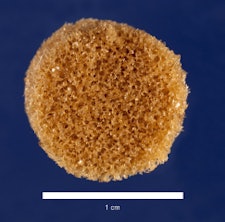 A new material that changes shape upon heating could help heal bone lesions caused by injuries, tumor removal, or birth defects such as cleft palates. (The white bar is 1 cm, or less than half an inch long.) Image courtesy of Melissa Grunlan, PhD.
A new material that changes shape upon heating could help heal bone lesions caused by injuries, tumor removal, or birth defects such as cleft palates. (The white bar is 1 cm, or less than half an inch long.) Image courtesy of Melissa Grunlan, PhD.To develop a better material, Grunlan and her colleagues at Texas A&M made a shape-memory polymer (SMP) that molds itself precisely to the shape of the bone defect without being brittle. It also supports the growth of new bone tissue.
SMPs are materials whose geometry changes in response to heat. The team made a porous SMP foam by linking together molecules of poly(ε-caprolactone), an elastic, biodegradable substance that is already used in some medical implants. The resulting material resembles a stiff sponge, with many interconnected pores to allow bone cells to migrate into and grow.
When heated to 140° F, the SMP becomes very soft and malleable. So, during surgery to repair a bone defect, a surgeon could warm the SMP to that temperature and fill in the defect with the softened material. Then, as the SMP is cooled to body temperature, it would resume its former stiff texture and "lock" into place.
The researchers also coated the SMPs with polydopamine, a sticky substance that helps lock the polymer into place by inducing formation of a mineral that is found in bone. It may also help osteoblasts, the cells that produce bone, to adhere and spread throughout the polymer. The SMP is biodegradable, so that eventually the scaffold will disappear, leaving only new bone tissue behind.
“It will help the outcomes of a lot of these surgeries and improve people's quality of life.”
"It can make contact with the adjacent bone tissue, and cells from the bone tissue will move into the foam and start to produce new bone," Grunlan explained. "As that happens, the foam dissolves away. At the end, you just have new bone tissue where the defect was."
To test whether the SMP scaffold could support bone cell growth, the researchers seeded the polymer with human osteoblasts. After three days, the polydopamine-coated SMPs had grown about five times more osteoblasts than those without a coating. Furthermore, the osteoblasts produced more of two proteins, runt-related transcription factor 2 (RUNX2) and osteopontin, that are critical for new bone formation.
The new technique is especially suited to maxillofacial reconstruction, Grunlan said.
"Craniomaxillofacial surgery in particular has an aesthetic component, and it really warrants a sophisticated material," she noted. "I think there's definitely a need for this, and it will help the outcomes of a lot of these surgeries and improve people's quality of life."
The next step will be to test the SMP's ability to heal craniomaxillofacial bone defects in animals, according to Grunlan. "The work we've done in vitro is very encouraging," she said. "Now we'd like to move this into preclinical and, hopefully, clinical studies."
The research was funded by the Texas A&M Engineering Experiment Station.




